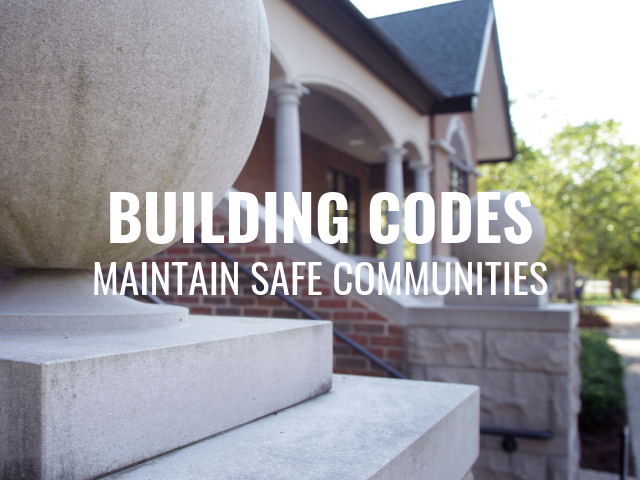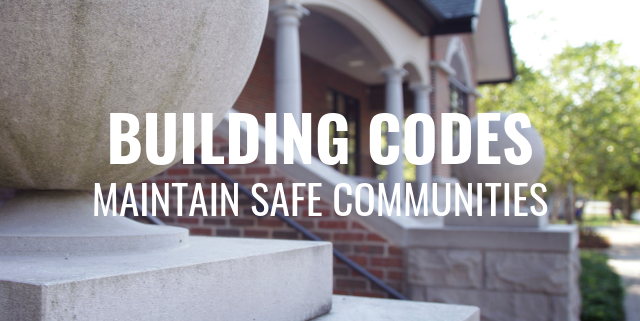The Role of Building Codes in Maintaining Safe Communities
 Building codes play an important role in maintaining safe communities. Each community adopts a building code to protect the health, safety, and welfare of building occupants. Architects refer to the code for guidance when designing buildings. Structures within the community that conform to the locally adopted building code are safer, healthier, and better for the buildings’ occupants and the wider community.
Building codes play an important role in maintaining safe communities. Each community adopts a building code to protect the health, safety, and welfare of building occupants. Architects refer to the code for guidance when designing buildings. Structures within the community that conform to the locally adopted building code are safer, healthier, and better for the buildings’ occupants and the wider community.
One of the first things we do when starting a building project is to find out the building code adopted by the community in which the building is located. Basically, this is the rule book that we need to follow. Building codes give direction to architects, contractors, and property owners who may wish to modify an existing building or build something new.
What are Building Codes?
Communities adopt Building Code regulations to maintain a safe and healthy built environment. Codes set the standard for structures within the community for construction, maintenance, and occupancy.
Building codes are minimum requirements that help safeguard the health, safety, and welfare of all building occupants. The codes govern the design, construction, remodeling, and maintenance of structures.
Ensuring fire safety is the primary focus of building codes.
- Keeping the structure from catching on fire
- Stopping a fire from spreading in a structure or to another structure
- Allowing safe evacuation of building occupants from a burning structure
Building codes include guidance on all the common parts of a building, including the structure, plumbing, electrical, mechanical, and more.
Codes include rules about the following:
- Structure
- Systems
- Mechanical
- Electrical
- Plumbing
Buildings within a community must conform to the rules stated in the adopted building code. Codes apply to all structures, including homes, multi-family buildings, commercial, industrial, and institutional buildings. Sometimes, structures like public schools are covered under separate code requirements.
In active seismic areas, building codes address earthquake resistance and focus on life safety in case of an earthquake. According to FEMA, “the most important factor in saving lives and reducing losses from an earthquake” is “the adoption and enforcement of up-to-date building codes.”
The International Code Council
Most communities where we work have adopted the International Code Council (ICC) code. ICC is a non-profit organization that develops model codes and standards that are adopted by communities and which we follow when designing buildings.
The ICC code is considered to be the definitive source for all US building codes. It is used by professionals in the compliance, design, and construction fields to help ensure that buildings are safe, efficient, economical, and resilient.
In 2000, three regional codes combined to form the ICC. These codes may be familiar to folks who built something prior to that time. In our area, BOCA National Code was adopted by most communities. In other areas, the SBCCI Standard Code and ICBO Uniform Code were more common. When all three codes came together as one code, uniformity of rules became a given. For us, it was much easier to understand the requirements, especially because we practice in a wide geographic area from California to Florida and New Jersey to Iowa.
Within the family of ICC codes, many municipalities have adopted the following model building codes:
- New Buildings – International Building Code (IBC)
- Existing Buildings – International Existing Building Code (IEBC)
- Green Buildings – International Green Construction Code (IgCC)
- Residential Buildings – International Residential Code (IRC)
Updating Building Codes
Codes are updated on a regular basis, typically every three years. Although it is not always the case, usually the codes become stricter with each update.
Experts in a variety of industries contribute to the final version of building codes. Building officials, architects, contractors, and industry leaders contribute their knowledge and expertise so that the code is as comprehensive as possible.
In addition, trade groups and organizations in the building industry contribute to building codes to help improve the built environment. Here are some of those organizations:
- American Concrete Institute
- American Institute of Architects
- American Institute of Steel Construction
- American Licensed Architects
- American Society of Civil Engineers
- American Society of Heating, Refrigerating and Air-Conditioning Engineers
- American Wood Council
- Construction Specifications Institute
- Engineered Wood Association
- Illuminating Engineering Society
- Truss Plate Institute
- US Green Building Council
What do building codes regulate?
In each community, building officials refer to the adopted building code when reviewing our drawings and specifications. Using the code as the definitive source, the code official determines if the proposed construction is safe, sound, and sanitary.
Did You Know? Building codes themselves are not legally binding. They are simply a guide. The codes only become law when a community adopts them.
Although codes are regularly updated, not all communities adopt the most recent version. We have found that each local authority has its own favorite version of the code, so it’s important to verify the current adopted code each time a new project is anticipated.
Codes regulate the following:
- Safety
- Quality
- Energy
- Accessibility
- Fire prevention
- Seismic
Codes do not regulate the following, as they are all locally determined:
- Setbacks
- Appearance
- Historic preservation
- Zoning
Interestingly, some building types do not need to conform to the building code. Institutional buildings, like public schools and hospitals, may fall under different requirements. Their design may be governed by separate codes, such as those adopted by the state. In these cases, we follow a completely different set of requirements, but the focus on the building occupants’ life safety, health, and welfare is the same.



